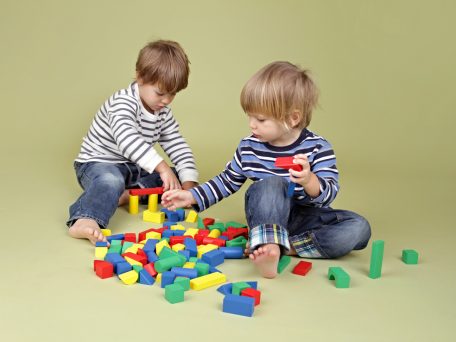Have you ever watched a group of young children playing together? They may use imaginative play such as playing house, or cooperative games like tag. Young babies and toddlers often play near each other, but don’t seem to be interested in actually playing with each other.
When children, especially very young children such as toddlers, play near each other it is called parallel play. Although it may feel like the kids are not socializing with each other, the reality is it is an important step to learning how to play together.
Solitary Play Vs. Parallel Play
At first, parallel play looks a lot like solitary play. When a baby or toddler is playing completely on their own, this is solitary play. Solitary play is when a child is off in a corner playing without anyone near at all, or playing at home when no one is available.
Parallel play is still playing on their own—but in this case children are near each other while playing. Two babies, for example, might be sitting on the same rug each absorbed in their own toy, or two kids might be playing in the same dollhouse without interacting.
Although both types of play don’t involve interaction, they are different. A child who is playing near others can still see what the other children are doing. They might watch one child pretend to put their baby doll to bed, and learn that this is something they too can do.
Indirect observation like this can help children gain new ideas for play, something they can also do while playing.
This first step—looking at what others are doing, may give them the confidence for the next step—playing directly with others.
How to Support Parallel Play
The best way to support Parallel Play is to give toddlers and babies the opportunity to play near each other. Daycare is a great option for this. If your child is in daycare, it’s most likely that they’re getting opportunities to parallel play every day.
If your child is not however, other ways to give your child these opportunities include play groups, park trips, and other situations where kids are available.
When kids are playing near each other, it’s best to let them play on their own with redirection only when needed.
If your child sees the same group often, you may even discover that your baby likes to sit near a specific baby or two to play near each time—the first steps toward friendship.
Final Thoughts
Parallel play is a valuable part of your child’s development. It takes time for children to learn about emotions, that the other babies and toddlers surrounding them are people too, and that they can be friends.
Parallel play is that first crucial step to learning those things, and it is very important. The good news for parents is that offering children this valuable type of play is as easy as plopping them down with a group of similarly aged children.
By giving kids these opportunities, you are helping them learn valuable skills for later in life, one parallel play at a time.








